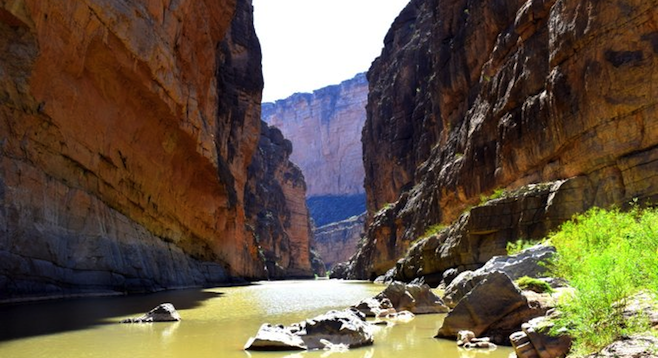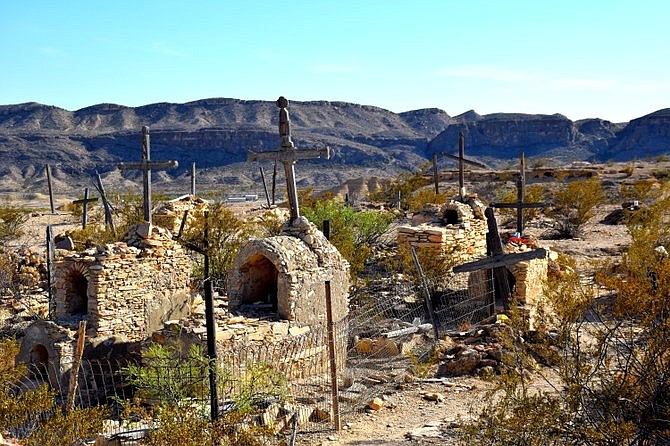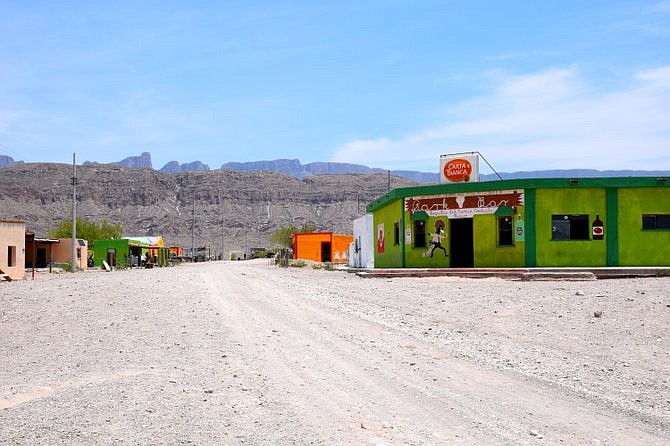 Facebook
Facebook
 X
X
 Instagram
Instagram
 TikTok
TikTok
 Youtube
Youtube

Big Bend is a massive national park that most outside of Texas have heard little about. The whole West Texas area that bends into Mexico, between El Paso and San Antonio, is often called “Big Bend country.” The actual national park lies in the southeast corner of the bend, spread out over a massive 801,163 acres. It’s easy to spend multiple days or a whole week in the park, but it can also be briefly explored in a day.
The night before entering the park we opted to stay in Alpine, 81 miles north of the park entrance on Highway 118. There’s not much on the road to the park, so be sure to load up on fuel and supplies before leaving.

On a suggestion from locals, we made an early-morning stop at the Terlingua ghost town, just a few miles before the entrance. There are several sights surrounding the once–mining town, but our main stop was the ghost town cemetery. Founded around 1900, it holds a large number of 100-year-old tombs.
After spending a short time at the cemetery, we booked it into the park. The “booking it” came to a halt shortly, though: we realized the speed limit within the massive park was 45 mph and strictly enforced by park rangers.
Our first stop within the park was the Santa Elena Canyon. The 1,500-foot canyon walls tower over the Rio Grande, one side of the canyon in Mexico, the other in the U.S. If you have enough time, you can take a short hike further into the canyon.
Our next stop was the Boquillas border crossing. It’s the only unmanned border crossing with Mexico, and allows you to travel to the small Mexican village of Boquillas del Carmen. (The crossing had been shut down for over 10 years, but recently opened up with the addition of a customs building.)
After passing through the building and talking with the lone ranger on duty, you walk down to the riverfront where boats from the Mexican side can pick you up. For five dollars you can catch a short ride to Mexico. Or if the water is low enough, you can simply walk across.
Once in Mexico, either walk the path to the village or pay to ride a burro or horse. We opted to ride horses, which was $8 per person round-trip. Once in town, we made a stop for lunch and beers at Jose Falcon’s Restaurant. You can pick up a couple entrees and beers for under twenty bucks, and you’ll likely be greeted by the owner’s daughter, thanking you for visiting the town.

After lunch, it didn’t take long to explore the rest of Boquillas. There are a few shops and a bar on a lone dusty street. Residents sell handmade trinkets in front of their homes.
After crossing the river back into the U.S., you’ll need your passport to enter. The ranger will walk you through the steps on the kiosk inside the building, during which a Border Patrol agent conducts a short interview by phone before sending you on your way.
Our last stop of the day was just outside of the park at the La Linda ghost town and closed international bridge. La Linda was once a Mexican mining town on the Rio Grande. A one-lane bridge, built by the mining company and manned by Mexico, still stands but is barricaded by the U.S.
You’ll have to exit the park headed north on Highway 385 to reach the bridge. Just a mile or so after leaving the park you will head southeast on FM 2627. This was the most desolate drive of the day; no cars passed and there was no cell phone service. A few miles into the drive you can stop at the Stillwell Store to fill up on fuel and snacks.

After another 24 miles you’ll reach the bridge. To the left of the blocked bridge you will see the ghost town, and to the right you will notice a pristine white cathedral, glowing in the Chihuahua Desert sun. The town’s supposed to be vacant, but during our visit we heard loud noises coming from one of the dilapidated buildings.
If you stay long enough, you are likely to encounter Fred, the only permanent resident of the area. Fred lives just uphill from the bridge and told us he’s lived there for 12 years. If you catch him on a good day he may even give you some history on the area.
After knocking out our last stop of the day around 6 p.m., we decided to head north for the small town of Marathon. The 67-mile drive will likely only be slowed by the Border Patrol substation a few miles before town.
Making it to Marathon by dark, we opted to stay at the Marathon Motel and RV Park. You can get a room for under $80, and the property offers an amazing courtyard with fountains and fireplaces.
On the way out of town you must realize there is only one gas pump in town, and the antique unit does not offer pay at the pump. If you get to the station too early, you may just be waiting for Ernesto to open up before you can leave town.


Big Bend is a massive national park that most outside of Texas have heard little about. The whole West Texas area that bends into Mexico, between El Paso and San Antonio, is often called “Big Bend country.” The actual national park lies in the southeast corner of the bend, spread out over a massive 801,163 acres. It’s easy to spend multiple days or a whole week in the park, but it can also be briefly explored in a day.
The night before entering the park we opted to stay in Alpine, 81 miles north of the park entrance on Highway 118. There’s not much on the road to the park, so be sure to load up on fuel and supplies before leaving.

On a suggestion from locals, we made an early-morning stop at the Terlingua ghost town, just a few miles before the entrance. There are several sights surrounding the once–mining town, but our main stop was the ghost town cemetery. Founded around 1900, it holds a large number of 100-year-old tombs.
After spending a short time at the cemetery, we booked it into the park. The “booking it” came to a halt shortly, though: we realized the speed limit within the massive park was 45 mph and strictly enforced by park rangers.
Our first stop within the park was the Santa Elena Canyon. The 1,500-foot canyon walls tower over the Rio Grande, one side of the canyon in Mexico, the other in the U.S. If you have enough time, you can take a short hike further into the canyon.
Our next stop was the Boquillas border crossing. It’s the only unmanned border crossing with Mexico, and allows you to travel to the small Mexican village of Boquillas del Carmen. (The crossing had been shut down for over 10 years, but recently opened up with the addition of a customs building.)
After passing through the building and talking with the lone ranger on duty, you walk down to the riverfront where boats from the Mexican side can pick you up. For five dollars you can catch a short ride to Mexico. Or if the water is low enough, you can simply walk across.
Once in Mexico, either walk the path to the village or pay to ride a burro or horse. We opted to ride horses, which was $8 per person round-trip. Once in town, we made a stop for lunch and beers at Jose Falcon’s Restaurant. You can pick up a couple entrees and beers for under twenty bucks, and you’ll likely be greeted by the owner’s daughter, thanking you for visiting the town.

After lunch, it didn’t take long to explore the rest of Boquillas. There are a few shops and a bar on a lone dusty street. Residents sell handmade trinkets in front of their homes.
After crossing the river back into the U.S., you’ll need your passport to enter. The ranger will walk you through the steps on the kiosk inside the building, during which a Border Patrol agent conducts a short interview by phone before sending you on your way.
Our last stop of the day was just outside of the park at the La Linda ghost town and closed international bridge. La Linda was once a Mexican mining town on the Rio Grande. A one-lane bridge, built by the mining company and manned by Mexico, still stands but is barricaded by the U.S.
You’ll have to exit the park headed north on Highway 385 to reach the bridge. Just a mile or so after leaving the park you will head southeast on FM 2627. This was the most desolate drive of the day; no cars passed and there was no cell phone service. A few miles into the drive you can stop at the Stillwell Store to fill up on fuel and snacks.

After another 24 miles you’ll reach the bridge. To the left of the blocked bridge you will see the ghost town, and to the right you will notice a pristine white cathedral, glowing in the Chihuahua Desert sun. The town’s supposed to be vacant, but during our visit we heard loud noises coming from one of the dilapidated buildings.
If you stay long enough, you are likely to encounter Fred, the only permanent resident of the area. Fred lives just uphill from the bridge and told us he’s lived there for 12 years. If you catch him on a good day he may even give you some history on the area.
After knocking out our last stop of the day around 6 p.m., we decided to head north for the small town of Marathon. The 67-mile drive will likely only be slowed by the Border Patrol substation a few miles before town.
Making it to Marathon by dark, we opted to stay at the Marathon Motel and RV Park. You can get a room for under $80, and the property offers an amazing courtyard with fountains and fireplaces.
On the way out of town you must realize there is only one gas pump in town, and the antique unit does not offer pay at the pump. If you get to the station too early, you may just be waiting for Ernesto to open up before you can leave town.
Comments